In our Technical Proposal for the Subcutaneous Transmitter, we layed out our plan for developing a transmitter small enough to be implanted in the body of a rat, fast enough to transmit four hundred data samples per second, powerful enough to be detected at a range of three meters, and efficient enough to operate for three months on a lithium battery. We divided our development into four stages.
On 19th to 20th February 2006, Kevan Hashemi, President, OSI, visited Matthew Walker at ION and completed delivery to him of eight Subcutaneous Transmitters (A3006), two Data Recorders (A3007), a LWDAQ Driver (A2037), Recorder Instrument data acquisition software for the LWDAQ software, and cables.
While these circuits work well for Kevan in his basement laboratory, they do not work in the presence of 950 MHz cellphone interference observed in Matthew's laboratory. This interference went unnoticed until now because one of the Demodulating Receivers (A3005) in Matthew's laboratory had a broken capacitor, reducing its gain dramatically. With the reduced gain, the receiver output was not saturating in the presence of the interference, and could receive signals from a Transmitter with Logic Chip (A3004) held close to the antenna. The other A3005 in his possession was working properly, and so saturated in the presense of the interference, and would not register the A3004 signal. Matthew, quite understandably, assumed that the receiver showing a signal was working, while the other one was not.
When Kevan arrived, he figured out what was going on after a few hours, and he and Matthew and graduate student Pishan tried to get the system working inside a Faraday cage. But the Faraday cage was ineffective at our RF frequencies. Matthew's cellphone worked well within its walls.
In the following sections we describe the performance of the new transmitters and receivers. We suggest a program of tests for Dr. Walker to perform with them at ION, and we discuss our plans for the next stage of development.
Starting with LWDAQ 5.3, the Recorder is available in the Instrument menu. You can run the instrument and acquire Subcutaneous Transmitter data from our test stand at Brandeis University.
In our A3005 manual, we show how interference stops our modulation system from working above-ground in the US and the UK. We also show how our modulation system does not work at short ranges because of slow turn-off. Our transmission system has the follwing problems.
We will address these issued in our proposals for Stage Four below.
A striking weakness of our RF transmission system is that we do not transmit data zeros. We transmit only data ones. A data zero is supposed to be the absence of a data zero. Because we have a limiting amplifier with a gain of ×2000, the moment a powerful data one disappears, we begin to amplify whatever interference or noise our antenna might be receiving, and so we can get false zeros. At close ranges, 950 MHz lingering from a previous data one can induce a false zero.
We can improve our system by transmitting zeros as well as ones. To try out zero transmission, we plugged in our modulating receiver, as shown here. The A3005 until now has had a response like that shown below on the left. We adjusted the LO frequency until the response looked like that shown on the right.

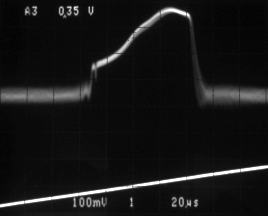
When we increase the LO to 1020 MHz, we downshift 950 MHz to an IF of 70 MHz instead of 50 MHz. The 70 MHz is displaced from the 50 MHz resonant frequency of the A3005's dual LC tank circuits. Although the RF frequency is increasing from left to right in the diagram, the IF is decreasing. Within the SAW filter passband, it decreases from 90 MHz down to 50 MHz. The peak response occurs at the upper end of the SAW passband.
By considering this diagram, you will see that it is now possible for us to transmit zeros with 960 MHz and ones with 940 MHz. We apply a square wave to our demodulating transmitter's VCO that steps between 1.2 V (960 MHz) and 1.0 V (940 MHz) for zero and one respectively. Here's what that looks like.
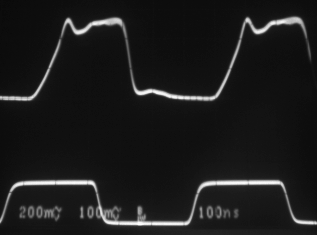
Even though the transmitter is less than 1 m from the receiver, notice that the transition between data one and data zero is fast. Both rise and fall times are around 50 ns. Here's what happens when we raise the bit rate to 20 MBits/s.
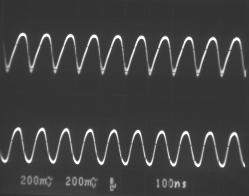
During both zero and one reception, the receiver output is noise-free. With our previous system, the zeros were noisy. The noise is still present at the antenna input, and the interference also. So why are the data zeros no longer noisy? We could accept that the data ones were noise-free in our earlier system, because the signal power was saturating the receiver output, so the noise did not make any difference. But now we see that the receiver output is not saturated during zero transmission, and yet the noise is still absent.
To understand what's happening, keep in mind that the amplifier limiting takes place before demodulation. If we have a 940 MHz signal that is ten times more powerful than any other arriving at the antenna in the receiver's passband, then this signal will dominate the output of the limiting amplifiers. The frequency of the square wave output from the limiting amplifier will be the frequency of this dominant signal, not the frequency of the lesser signals. The lesser signals will shift the square wave frequency slightly, but only in proportion to their relative power.
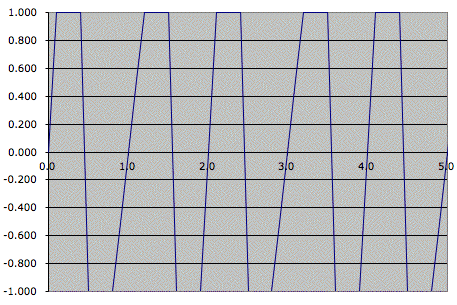
As you can see in the above figure, even when the power of the lesser signal is half that of the larger, the frequency of the amplified and limited signal is almost exactly equal to that of the larger signal. Further increase in the lesser signal's power leads to a sudden change in the apparant frequency, as you can see below.
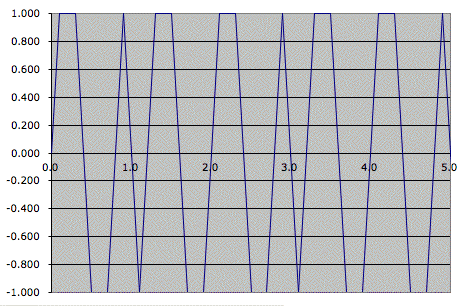
So long as the signal power is two or three times greater than the combined noise and interference powers, we should still get the correct limited IF square wave frequency coming out of our IF amplifier. We then pass this square wave through an LC tank circuit that attenuates frequencies higher than 50 MHz. A square wave of 90 MHz is attenuated by a factor of two in amplitude. Now we rectify the attenuated wave (demodulate it) and get a clean output of 200 mV for a 90 MHz input, and 400 mV for a 50 MHz input. There is no noise on the output because the noise has been dominated by the signal.
It is this domination of noise by the signal during the limiting amplification that gives FM radio its noise-free sound. Either the signal is strong enough to dominate noise, in which case the output is clean and noise-free, or the signal is not strong enough, in which case the output is suddenly lost and we have loud noise created by the high-gain limiting amplifier.
Our next receiver will have higher gain. It will amplify thermal noise until it causes a saturating square wave at the output of the limiting amplifier. Any time we have a signal stronger than our noise and interference, the limiting amplifier output will suddenly begin to alternate between our data-zero and data-one frequencies. We will recognise the beginning of a transmission by a pattern of data zeros and ones that distinguishes the transmission from the usual noisy output.
Our choice of 950 MHz as our operating frequency was based upon a 30-MHz bandwidth SAW filter we could buy from our favorite component supplier. Subsequent investigation reveals that we are operating in the US radio station uplink frequency. Radio stations transmit their audio feed to the FM antenna via a 950-MHz link; that way they don't have to have the large FM antenna on top of their office building. In Europe, meanwhile, 950 MHz is used for cell-phone networks, as you will see here.
We should instead be using the ISM (Industrial Scientific Medical) frequency band, between 902 MHz and 928 MHz. We have purchased a 900-MHz ISM band SAW filter with passband 915±13 MHz. Our data-zero frequency will be 908 MHz, and our data-one frequency will be 923 MHz. These tighter frequency tolerances will require us to tune the transmitters, which we can do with a suitable test fixture that serves both to program the transmitter's logic chip through spring-loaded test pins, and set the mid-range frequency by means of a four-bid DAC made out of four logic outputs and four resistors. We will measure the output frequency with a new Spectrum Analyzer circuit.
While we are pleased with the performance of the Data Transmission and Reception Circuits in our basement laboratory, they have not yet performed well in London. We claim this is soley because of 950 MHz interference.
A Spectrum Analyzer circuit is our highest priority at the moment. It will connect to the LWDAQ and provide a power density spectrum for frequencies 850 MHz to 1050 MHz. We will send one to Matthew Walker so that he can determine whether the ISM band is relatively clear in his laboratory.